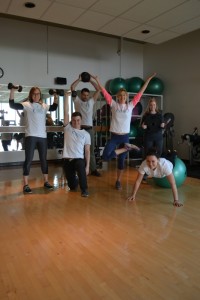Camosun College is offering a new club that focuses on how exercise can help those living with type 1 and 2 two diabetes.
It’s called Exercise is Medicine, and club founder Hannah Flahr, who is also a Sport and Fitness Leadership student, says that the club filled up fast.
“Diabetes is on the rise, and the effect of exercise on diabetes is really prominent in the research right now. It’s widely researched across Canada and the world,” says Flahr. “So rather than create a program for kids or some athletes, we thought, ‘Why don’t we create a program for a chronic disease?’”
Exercise is Medicine program facilitator and Sport and Fitness Leadership student Melissa Rollin says that they have learned a lot about the impact exercise has on diabetes, and they’re eager to share that information.

“In our class, we learned all about the effect that exercise has on diabetes, both type 1 and type 2, so we’re bringing that information and resources from Diabetes Canada into the sessions.”
According to Flahr, each session begins with a 15-minute talk on diabetes education, followed by 45 minutes of circuit training and body-weight exercises.
“It’s about six to 10 exercises,” says Rollin. “We have additional dumbbells that they can grab if they want more weight, and when you do it in a circuit style like that, you’re doing your resistance training, but you’re not stopping. It’s cardio, so it’s getting the blood flowing.”
All volunteers in the club are Camosun students. Rollin says posters and sign-up forms were taken to various gyms throughout the city.
“Some of us students knew doctors, so we would bring the poster with the registration information to the doctors officeÉ it was advertised widely in the community so that we would have lots of different people. Throughout our program, people who work at Camosun have opportunities to pair up with students to get trained, so we wanted to make sure that the whole community would be involved as well.”
Rollin says it is rewarding to watch people with diabetes, many of whom have lived relatively sedentary lives, get moving again.
“It was really nice to see that we’re putting something out there that is the kick in the butt that somebody needed, and we’re there for them to help them through this.”
Rollin tells one story of one of the group members saying he was “allergic to exercise,” but then realizing during a session that it actually felt good to be moving.
“It’s great to see that they’re growing and the exercise is sparking an interest and a passion in them,” says Rollin.
She does admit, however, that it’s sometimes a challenge to find what she calls “adaptations” to the exercises in order to cater to everyone’s needs.
“We’ll have different heights for the steps, different weights, just to make sure everybody is moving. And with so many of us there, we can all brainstorm and just try and think of a different exercise that will stimulate the same muscle group, so that everybody can keep moving through each exercise as a circuit.”
Exercise is Medicine is being offered at the Pacific Institute for Sport Excellence at Interurban campus on Tuesdays and Thursdays from 6 to 7 pm.
